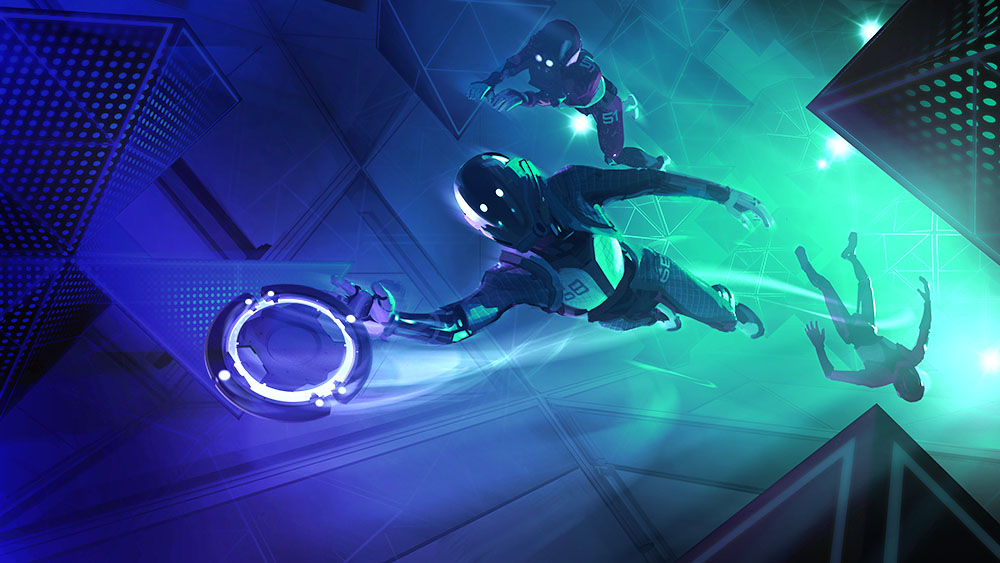Oculus is currently in the middle of its “Summer of Rift” campaign, which features a limited price reduction to $399 of the Rift VR headset.
But what’s the point of buying a new headset when you don’t know what games to get? Oculus has that area covered, too, with free gameplay trials of some of its hottest games, particularly Lone Echo, which launched last week exclusively for the Rift.
Lone Echo was developed by Ready at Dawn Studios, which made a name for itself with the Victorian Era, supernatural sci-fi horror action game The Order: 1886 for PlayStation 4. What makes Lone Echo an especially interesting game for Oculus users is that it’s actually two games merged into one. There’s the single-player story, where players take the role of a sentient AI named Jack who uses a robotic body to explore a space station alongside the computer-controlled human character Captain Olivia Rhodes. Then there is the multiplayer component, Echo Arena, which is a kind of VR sport that Oculus is presenting as an esport like it has with The Unspoken.
Echo Arena was awarded Best VR Game at E3 this year, where professional esports teams The Immortals and Counter Logic Gaming (CLG) went head-to-head. In it, teams of four compete against each other in a zero gravity arena by passing a disc and stunning opposing players to score goals. Ru Weerasuriya, founder, president, studio head and creative director at Ready at Dawn Studios, described it to AListDaily as “a full-contact VR sport set in the Lone Echo world. It’s a mix of rugby-meets-ultimate frisbee—all mixed together.”
We're at #E32017 about to face @Immortals in Echo Arena on @OculusRift! Catch it LIVE here: https://t.co/NWqiWOlxIl #ad pic.twitter.com/evUccHVI6v
— Counter Logic Gaming (@clgaming) June 13, 2017
Both games are under the Lone Echo brand, and the multiplayer mode was created when the developer decided to explore the social aspects of VR. Echo Arena is included with Lone Echo, but it’s also offered as a standalone game that will be free to play until October courtesy of a partnership with Intel.
“We wanted to give something to the VR community,” said Weerasuriya. “Intel, Ready at Dawn and Oculus decided to make it free for three months so everybody could jump in and play.”

Lone Echo came from a conversation Weerasuriya had with Oculus’ vice president of content, Jason Rubin, where they discussed transitioning content from short VR apps to full-length AAA games. Although Lone Echo won’t necessarily be the same length as a Call of Duty game, Weerasuriya said that it will help bridge the gap and pave the way for more AAA VR games.
In addition to presenting the game at tentpole events like E3, Weerasuriya said that Ready at Dawn and Oculus have been promoting Echo Arena through non-traditional means.
“We’re accustomed to making games and using traditional marketing and PR means like TV trailers,” he explained. “This time, it was through Oculus Connect and building a community as soon as we started the beta. We were surprised to see how the community attached to it an evangelized the game. As that happened, we realized that we wanted this to build up through the grassroots and players. It’s a very refreshing way to approach our players.”
As for getting more people to try VR for the first time, Weerasuriya said that “there are many entry points, depending on which platform you want to use, and there are some cool experiences for Gear VR. Luckily for us, there are enough competitors in the market between all the different platforms so that you can get a start with VR.”
Weerasuriya talked about how Oculus has been working to lower the barrier to entry for VR, stating that even viewers like the Samsung Gear VR may be a good starting point for many, as it provides a sense of immersion that proves how VR isn’t just another gimmick as it might have been in the past.
Additionally, the lowered price of the Oculus Rift has made it possible for many to adopt premium VR, but there’s still a ways to go before we see mass adoption.
“We’ve seen a whole bunch of players jump into Echo Arena because they got a Rift recently,” said Weerasuriya. “I think what’s keeping people from getting into VR now is the accessibility of the technology, but there are VR cafés coming up. It’s hard to convey VR through traditional means, so we need word-of-mouth to drive it right now.”
Games like Echo Arena will be critical to the success of VR because of its social elements. Coincidentally, Ready at Dawn’s first experience with VR was through Sony’s Project Morpheus, which later became PlayStation VR. Weerasuriya told a story about the connection he felt to an avatar that handed him something.
“That person felt real to me,” Weerasuriya explained. “So, we went back and realized that it’s one thing to have a presence inside a world, but it’s another thing to have immersion, which Oculus Touch gives you—the tactile feeling of being inside the world. Once those ingredients were there, we wondered what would happen if we added more people to the experience. So, we thought about the kinds of connections we wanted to build with players through the gameplay mechanics we built in Lone Echo. That turned into Echo Arena, a game where social interaction—speaking, gesturing and grabbing onto someone—matters. That social interaction is what builds it as a sport.”
However, the story leads to the question of why the developer decided to work with Oculus. Weerasuriya stated that it came down to creating diversity in the VR space.
“Let’s say that everybody that went into VR did similar things. You’d have a stale ecosystem. Facebook and Oculus want to build diversity. Deciding to work with Oculus was because Jason [Rubin] was there and understood that diversity needed to exist. We could bring something the VR didn’t yet have. For us, it was about exploring some of the themes that we had in past games but in VR and having a computer controlled player that you could interact with.”
Weerasuriya has been asked on numerous occasions whether The Order was being made in VR, which it isn’t, but fans will definitely see some elements in Lone Echo.
The bigger challenge for Lone Echo was presenting the game’s single-player experience and its entirely different multiplayer mode.
“That has been very interesting and tricky because we originally started by just showing Lone Echo at E3 last year. However, Echo Arena was ready to be shown, so we had to think about how people were going to perceive it. Would they understand that they’re both part of the same game?
“Having them be part of the same IP helped, and once we put people in Lone Echo and moved them to Echo Arena, they understood that all the mechanics were the same. The commonality made it easy to show both games, but we purposefully chose not to show them together over the past few months for one specific reason—we wanted to hold a little bit of secrecy behind the Lone Echo experience so that players could discover the story without too much being revealed.”
The focus then shifted to promoting Echo Arena, because it was likely to attract more people to VR due to the social aspects. Although the game only just recently launched, it is already being promoted as an esport, which could be a risky move.
“We started by saying that Echo Arena needed to be supported by the community, and it will decide whether it becomes an esport. It was hard for us to say that we were going to make a game that was going to be an esport. But with that said, as we were working on it, everyone who saw the game said we were building an esport.
“As much as I wanted to hold true to having the community make the game an esport, having Intel come and talk to us about what they wanted to do with the game—and Oculus encouraging us to embrace the idea—made us think that maybe we could release it to the world as an esport. Intel wanted to do a VR challenge series as we were putting in features like spectator mode, and things seemed to align perfectly. Ultimately, whether or not the game survives will be up to the players, but we invited The Immortals and CLG to play at E3 this year, and it was cool to see esports teams gravitate to it. We’re embracing how people are seeing Echo Arena as an esport, and we’re going to support it as much as the community wants us to.”
Echo Arena supports custom uniforms, so there are branding opportunities there for teams and sponsors. The Immortals and CLG were able to put their uniforms onto their avatars during their E3 match.
So, how will Weerasuriya and company measure success for Lone Echo and Echo Arena, given the limited player base?
“Our bar for success this early on in VR is if people embrace some of the barriers that we’ve been able to break,” Weerasuriya said. “We hope that everyone who gets their hands on this game will celebrate some of the work we’ve put in with the movement models, the immersion, AI, face capturing for the single player story, and the competitive aspect with Echo Arena. That’s our measure of success because we’re at the start of the cycle and the user base needs to grow over the next few years.
“We want people to feel like there’s a future to VR. Maybe someday someone will take something from Lone Echo and do something different with it. That’s how our industry, our games and VR content grows. We’re in the wild west right now—it’s all new. So, having those things become the staples in VR is a measurement for success. The other measurement is how communities will grow around Echo Arena, and we’ve already seen that with the beta. The ultimate measure of success is having your players become your fans and your biggest promoters.”

